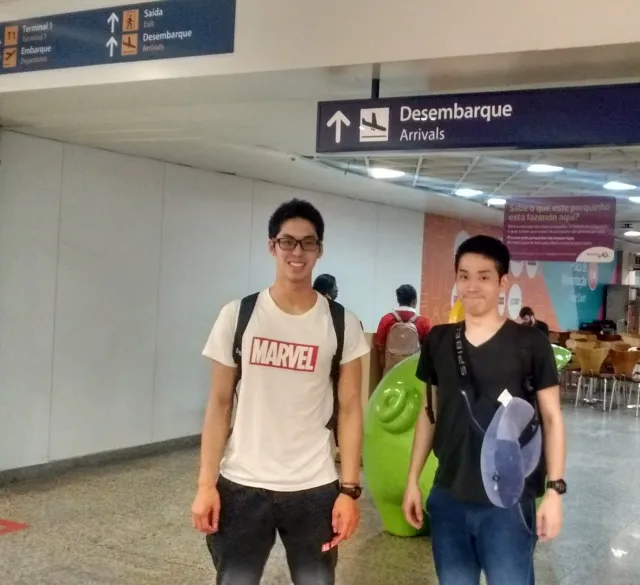2018 Activity Report
March Activity Report
31 March 2019
Global Japan Office Coordinator
Leonardo Brescia de Sousa Henriques
On March 14th, it was opened at the Cultural Center of the Rio de Janeiro State University the exhibition “The Power of Shojo Manga”, curated by Prof. Masami Toku and organized by The Japan Foundation in São Paulo, the Cultural Department of UERJ and the Department of Japanese of UERJ with support of the GJO. A few days before the opening, some UERJ undergraduate students of Japanese helped to arrange the place for the exhibition that will last until April 11th. Prof. Elisa Massae Sasaki made three guided visits to the exhibition to explain to students and general public about the Shojo Manga.
The exhibited works reveal the female point of view through manga and show the change of roles of the Japanese women over time.
The works are divided in three chronological periods: (a) “the birth of the modern Manga Shojo” — from the Second World War to the 1960s; (b) “the development and diversification of the modern Manga Shojo” — from the 60’s to the 80’s and (c) “the new generation of the modern manga shojo” — from the 80’ to the present time.
Works of twelve artists are at the exhibition divided in the mentioned above periods as follows:
First Period: Leiji Matsumoto, Masako Watanabe, Hideko Mizuno and Miyako Maki.
Second Period: Nachiko Satonaka, Suzue Miuchi, Moto Hagio, Akimi Yoshida and Fusako Kuramochi.
Third Period: Reiko Okano, Ichiko Ima and Fumi Yoshinaga.
Here are some pictures of the exhibition:
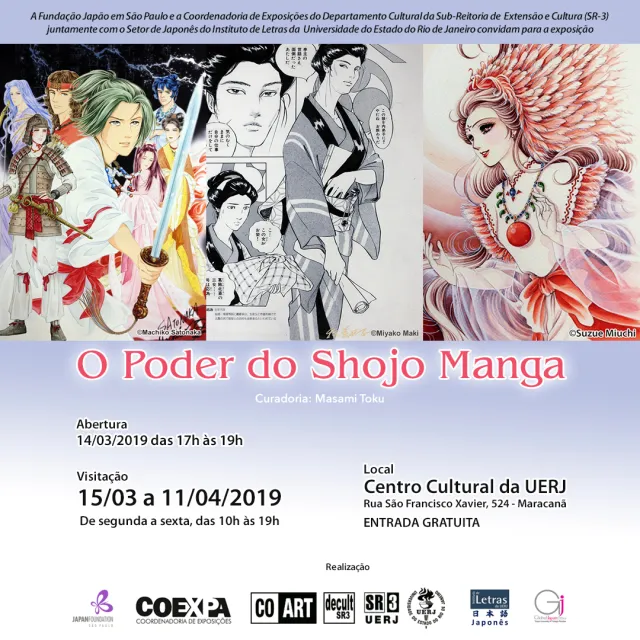
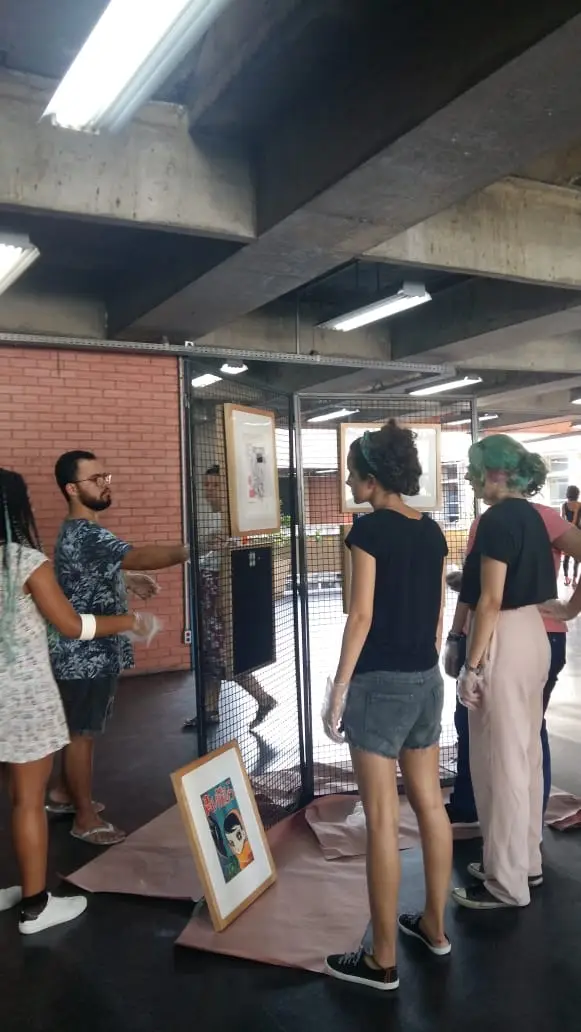
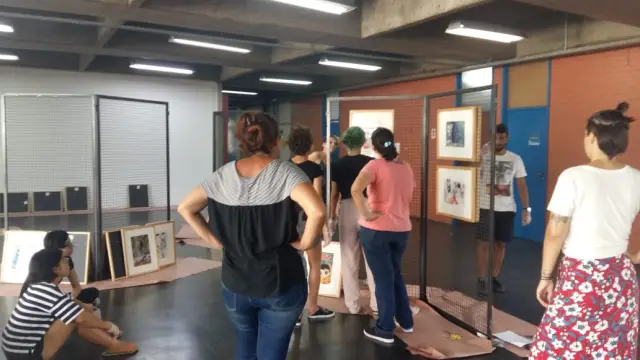
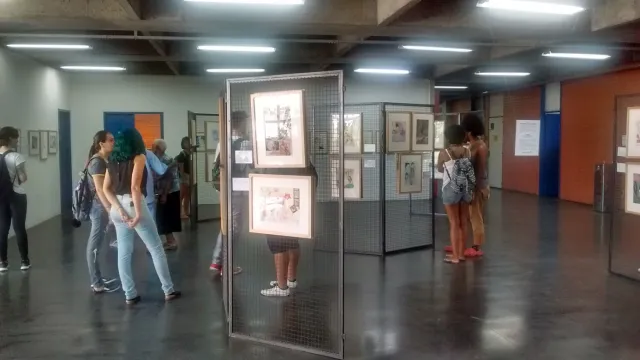
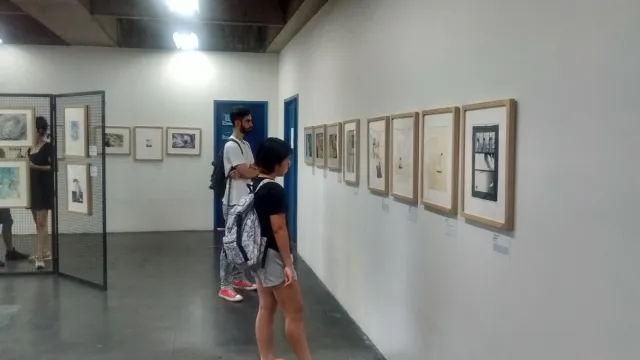
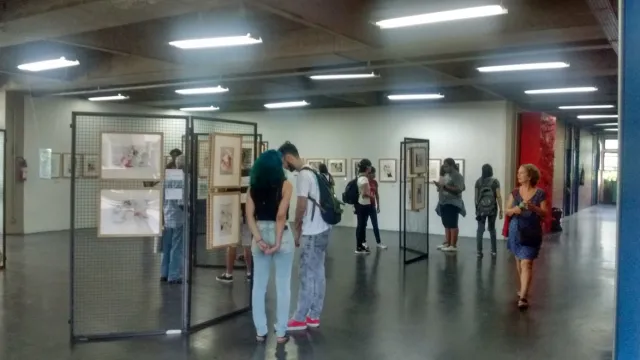
February Activity Report
28 February 2019
Global Japan Office Coordinator
Leonardo Brescia de Sousa Henriques
This month, it was offered for the first time at Rio de Janeiro State University an immersion course of Portuguese Language and Brazilian Culture specific for Japanese students. It was called Rio de Janeiro Summer Session 2019, and was held from 4 to 22 February. The Japanese Department in partnership with NUPPLES (Portuguese as a Second/Foreign Language Teaching and Research Center), LICOM (Language for Community Project) and GJO organized the course.
Ten students out of fourteen came directly from TUFS to take this course in Rio. The lessons were given by Prof. Alexandre do Amaral Ribeiro and Prof. Débora Marinho Guerra with support of three interns.
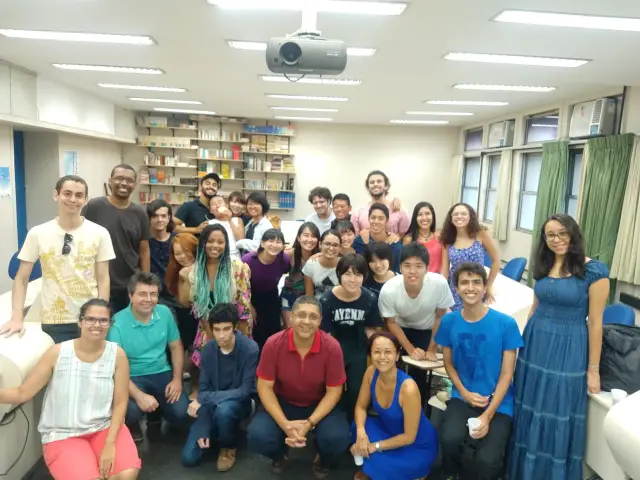
On the first day, we had a welcome party, where six musicians, including three vocalists, performed Brazilian songs with acoustic guitars and a clarinet. Some snacks and soft drinks were offered and the Japanese students presented themselves. Brazilian students and the host families were also invited to the celebration to meet the Japanese students.
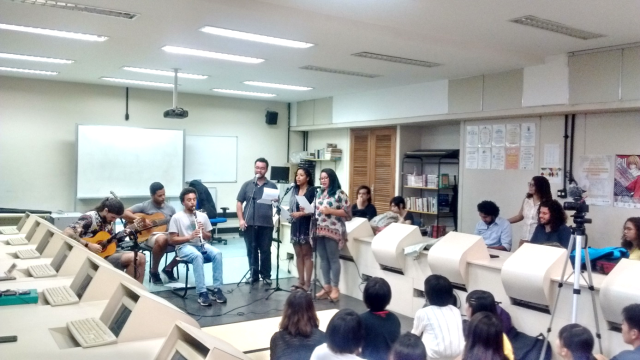
In addition to the lessons in classroom, the students made some cultural visits to other institutions, some of them out of the Rio de Janeiro City. Some Brazilian students accompanied the Japanese students so that they could practice Portuguese.
The first visit took place on 8 February. The group was taken to Fazenda Alliança in Vale do Café. Vale do Café (literally “Coffee Valley”) is composed of more than ten cities located in the countryside of Rio de Janeiro State. In the 19th Century, this region produced about 75% of the coffee consumed in the world. For this reason, Brazil became the world leadership in the production and export of coffee at that time. Nowadays some of the historical farms are open to visitors that can observe how coffee was produced, appreciate the architecture, furniture and the machines used at that time, understand some religious aspects as well as details about the life of the landowners and the slaves.
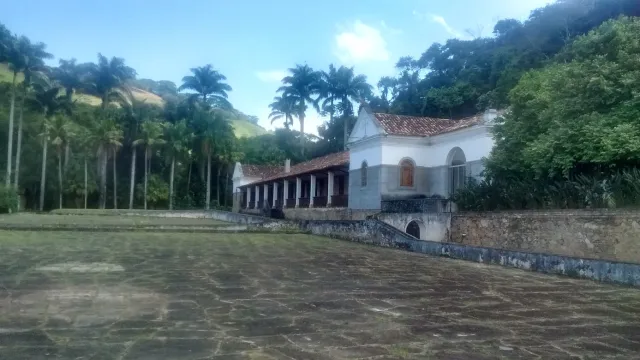
The second visit took place on 11 February at Estúdios Globo, the largest Brazilian television complex and the second largest one in Latin America. Several Brazilian television shows are created at Estúdios Globo, including soap operas that are sold to diverse countries of the world. The students could visit the rooms where more than 100,000 costumes are stored, talk to artists and observe their artistic production such as fake food, kitchen utensils, animals and all kind of objects that look incredibly real, in addition to visit scenarios and a whole scenographic city.
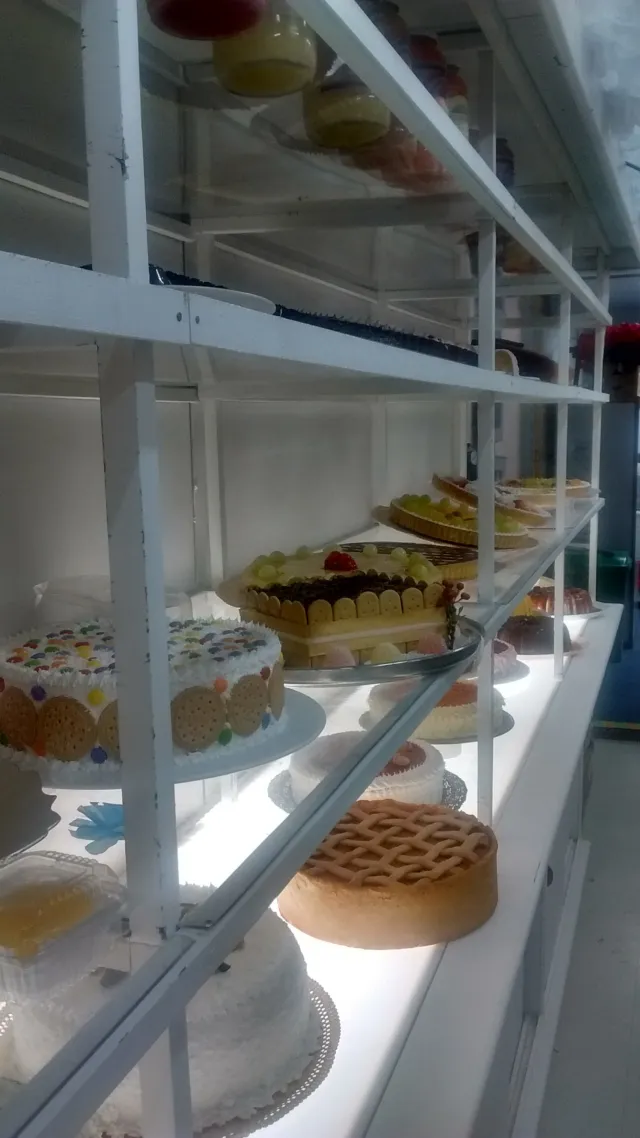
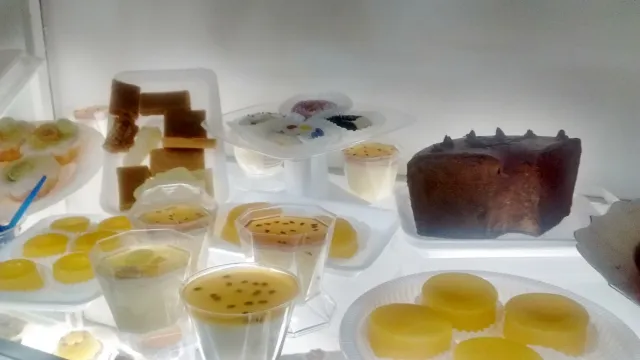
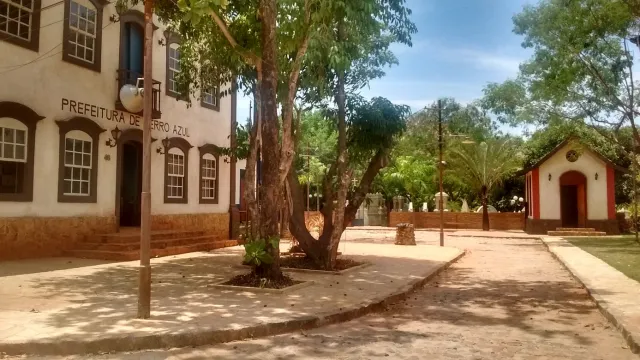
The next visit took place on 15 February in the historical and Diplomatic Museum of the Itamaraty Palace, in Rio de Janeiro city center.
This Palace, a 19th century Neoclassical building, was the Ministry of International Relations from 1899 to 1970. In the building, there is also a historical archive that includes documents such as the first agreement between Brazil and Japan: “Agreement of Friendship, Commerce and Navigation” signed in 1895, written in Japanese, Portuguese and French. This one and other agreements were previously taken from the archive exclusively to be shown to the group.
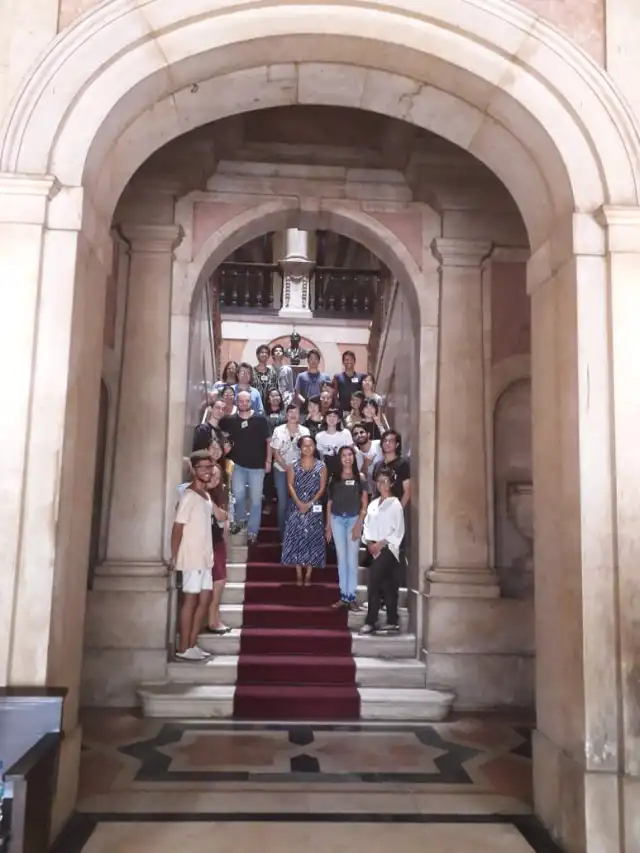
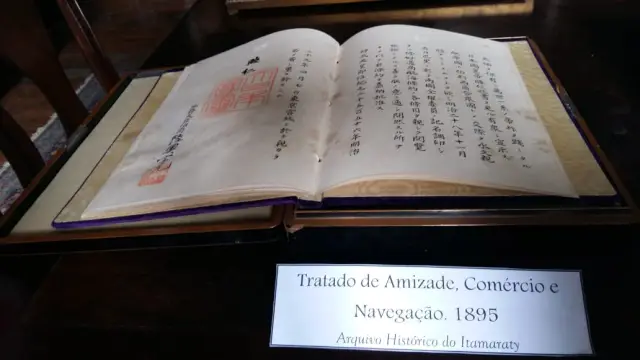
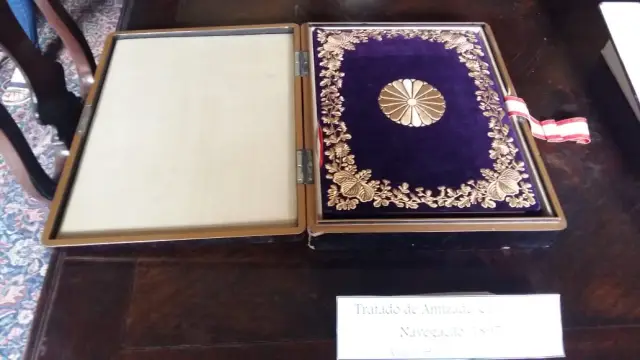
The last visit took place in Petrópolis City on 21 February. At first, the group visit the former address were the First Japanese Legation was settled in Brazil, from 1897 to 1903. Nowadays the place is a hostel, named Pousada Dom that preserves its historical identity and shows a little bit about the Japanese Immigration to Brazil. Mr. Kiyoshi Ami, President of the Petrópolis Nikkei Association and his wife Mrs. Michiko Ami welcomed the group at Pousada Dom and made a lecture about the history of the Japanese Immigration to Brazil from the beginning of the 20th Century up to nowadays including the immigration to Petrópolis City. This meeting was possible thanks to Mrs. Marcia de Paula, Mrs. Marilia Mil, members of the Petrópolis Convention Visitors Bureau, and the owners of Pousada Dom that gently showed the place and offered a breakfast to the whole group.
After that, the students visited the Santos Dumont House, a museum that for some time was the home of Santos Dumont, a Brazilian inventor that became famous in the beginning of the 20th Century.
The group visited also a chocolate factory called Katz, where they could observe the production process.
At last, the students went to the Imperial Museum that in the 19th Century was the Summer Palace of the Brazilian Emperor Dom Pedro II. The collection of the museum includes furniture, documents, art pieces, musical instruments, personal objects of the Royal Family, clothes and jewelry, including the crown of the Emperor. The visit to this museum was an opportunity to the students to learn aspects of the Brazilian Monarchy in the 19th Century.

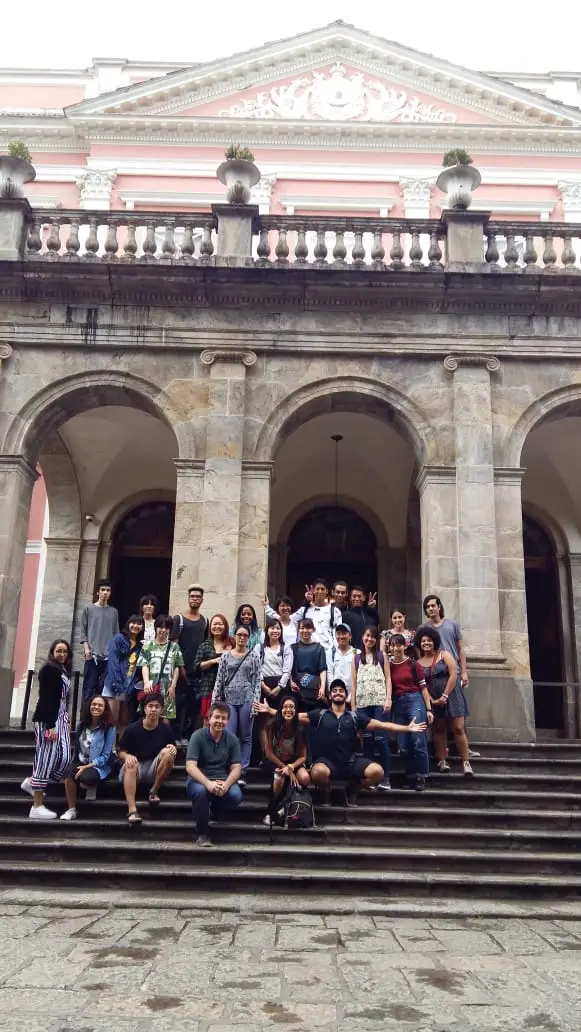
January Activity Report
31 January 2019
Global Japan Office Coordinator
Leonardo Brescia de Sousa Henriques
1) This month, during the summer holidays, 21 Brazilian students who study Japanese at UERJ and two students from Universities in São Paulo State had the opportunity to live a whole week in a Japanese environment, thanks to the First Workshop of Japanese Language and Culture at the Nippakuji temple, in São Paulo city. The workshop was organized by the Department of Japanese of UERJ, the temple Nippakuji and the Global Japan Office.
The first aspect of the workshop that must be mentioned are the meals. It was prepared typical Japanese food, such as Gyudon, Katsudon, Tendon, Teppanyaki, Robatayaki, Temaki, Udon among others for breakfast, lunch and dinner. The students helped to prepare the dishes for dinner, including the pasta for Udon, under the guidance of Monk Milton Yamada, who managed the kitchen the whole week long. The breakfast was maybe a surprise for some students, since in Brazil it is not usual to have rice in the morning. It was a good experience for those who wish to study or live in Japan someday.
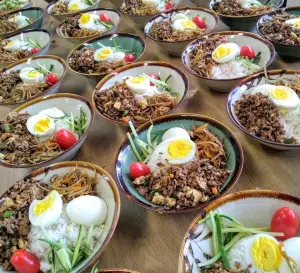
Regarding the academic activities, Prof. Satomi Kitahara gave classes of Japanese Syntax, so that the students could improve their skills in translation from Japanese into Portuguese. At the end of the lessons it was noticeable how easier it was for the students translate from Japanese.
Several other activities were offered: on the first day of the workshop, Monk Eduardo Ryoho Sasaki presented in Japanese the lecture The Buddhism and the Japanese Culture in which he talked about the history of Buddhism and the importance of the religion to the Japanese people.
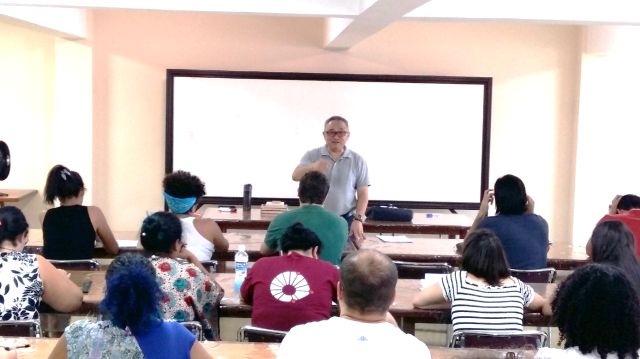
Monk Yamada (the same Mr. Yamada who managed the meals), skillful in different activities, gave a lesson of shodô and taught the students how to make ikebana. For the shodô lesson, in addition to the theoretical explanation, the students could practice the calligraphy, by copying a text, using all the utensils of shodô. The most skillful student received a writing brush (fudê) to keep practicing at home. For the ikebana lesson, Monk Yamada made bamboo pots and bought a lot of flowers, so that each student could make at least one ikebana by himself. Mr. Yamada taught the meaning of the ikebana, some basic concepts of the art and how to cut the flowers, so they can last for a longer period of time.
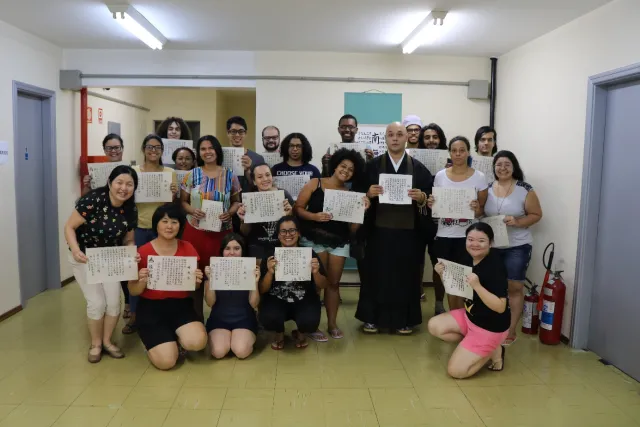
To buy the flowers, in the middle of the night, for the Ikebana practice on the following day, Mr. Yamada counted on the support of a couple of students. To choose the students who would accompany him, the students themselves decided to arrange a “Hyakunin Isshu” contest, playing in pairs. Thus, the winners went to the CEAGESP, the largest food wholesale market in Latin America, to buy flowers.
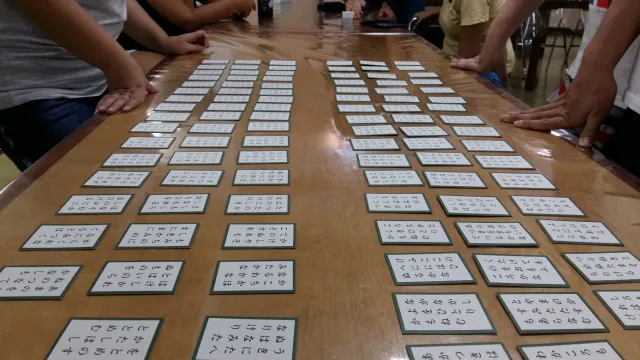

Some Japanese artists who live in São Paulo were invited to take part in the workshop to present artistic aspects from Japan. Mr. Hiroshi Ina, a very experienced haiku writer, gently went to the workshop to evaluate the haiku done by the students. Indeed, the students were previously asked to take two haiku to the workshop, using the expression “natsu no ame” and “shinnen”. In addition, the students had to write one more haiku in 15 minutes during the meeting with Mr. Ina using the word “semi” or “kaeru” (frog). In the end, Mr. Ina and all the students read all the haiku and the best works, chosen by the whole group, were published in a local newspaper by Mr. Ina.
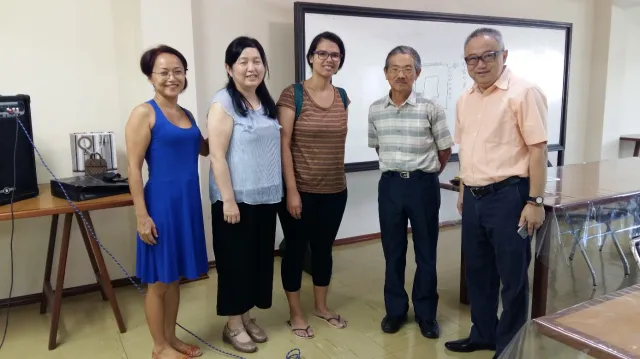
Other artist that was invited to the workshop is Mr. Masaru Susaki, a master in sadô, who is also the General Director of The Japan Foundation in São Paulo. Mr. Susaki performed the Tea Ceremony with the assistance of a Japan Foundation officer and a student. For most students, that was the first time that they had contact with the Tea Ceremony, live. After the performance, Mr. Susaki made a lecture named The Tea and the Japanese People to explain the history and the basics of the art.
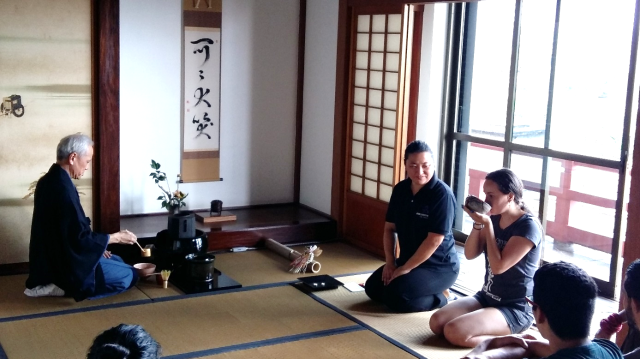
In the last night, some of the students performed some songs, singing in Japanese and playing the piano. After that, Monk Yamada made a touching speech to close the event.
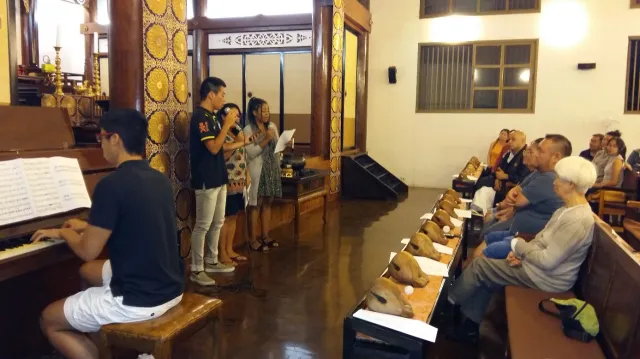
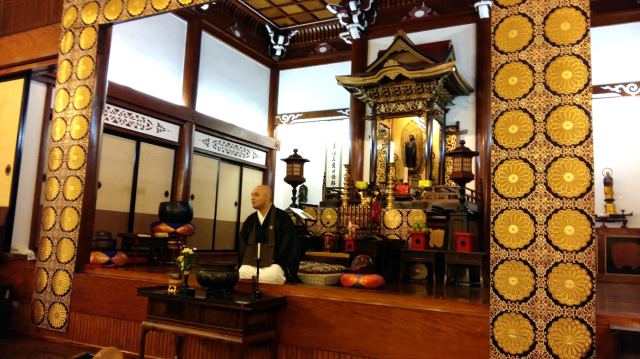
Considering all the artistic activities, we could notice that some students have a gift or a skill that must be developed. Some of them can write creative haiku, make beautiful ikebana, amazingly sing or make shodô as if they have always done that.
Before leaving São Paulo, on Saturday morning, the students were taken to the Immigration Museum, where they could learn a little more about the history of the foreigners that gave their contribution to the São Paulo City, including the Japanese people.
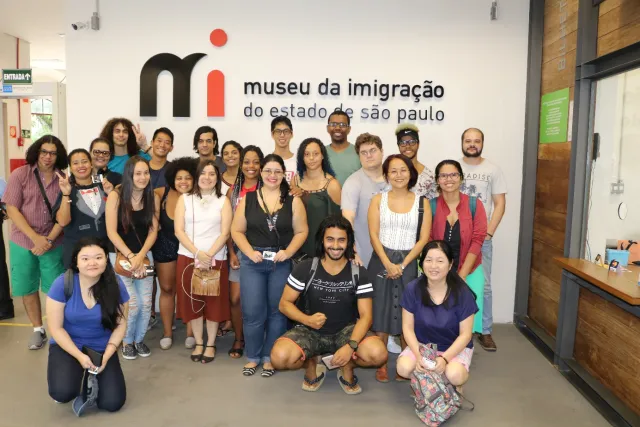
This was an intensive and prolific workshop and we hope to repeat it next year.
2) On the last day of the month, we had the pleasure to receive Prof. Gen Kuno, Senior Specialist in Japanese Language Teaching from The Japan Foundation in São Paulo, who gave a workshop concerning Japanese teaching for elementary and high school levels, named中等教育機関教師の講習会. The audience consisted of Japanese language teachers and students of the undergraduate courses of Japanese in Rio de Janeiro. Issues such as the Process of Second Language Acquisition and Organization of Class, drills, practice for communication purposes were part of the program.
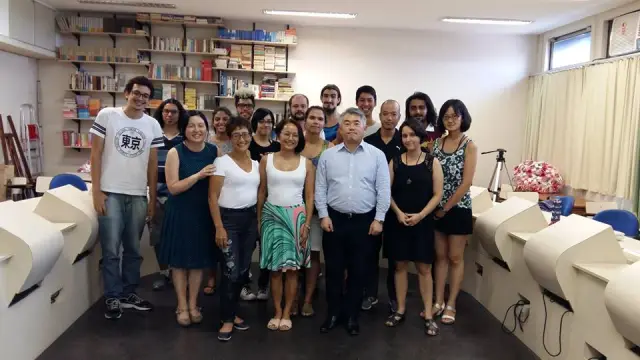
December Activity Report
31 December 2018
Global Japan Office Coordinator
Leonardo Brescia de Sousa Henriques
1) In this month, we had two interesting events related to Japanese culture at Rio de Janeiro State University (UERJ). The first one, held on 6 December, is a lecture titled The Meiji Restoration – What can contemporary Japan and Brazil learn from it?. This was the last event of the year related to the extension project “Discovering the Japanese Culture”. It was co-organized by the Department of Japanese of UERJ, the General Consulate of Japan in Rio de Janeiro and the Global Japan Office. The speaker, Consul General Yoshitaka Hoshino talked about the Meiji Restoration and the various reforms that took place throughout Japan, pointing some aspects that we must take into consideration to reflect on the contemporary Japan and Brazil. Here are pictures of the event:
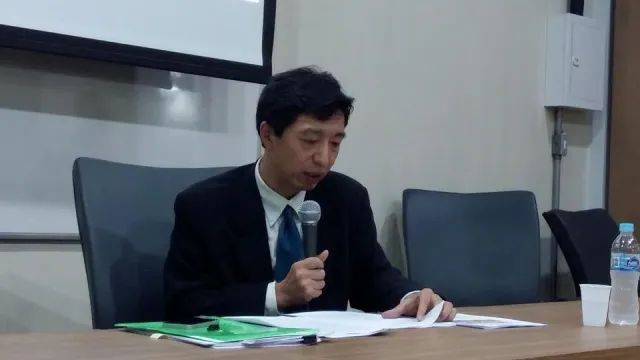
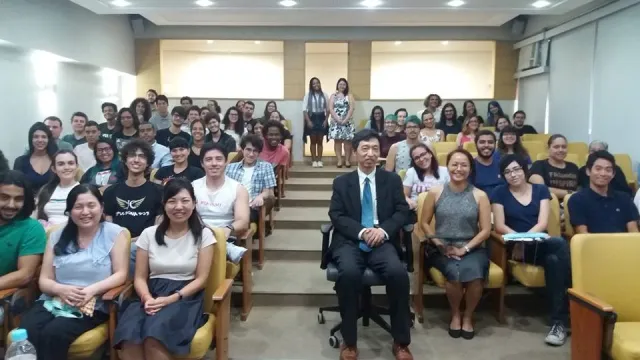
2) The second event of the month is not only related to the Japanese culture, since it was the “50th Anniversary of the Institute of Letters of UERJ”, in which each Department of the Institute presented some aspect of its respective foreign culture. It took place on 12 December. The Japanese Department presented Japanese songs such as Kawa no Nagare no youni, Itsumo Nando Demo, Mononoke Hime in addition to the song by Beatles Hey Jude with lyrics in Japanese and in English, performed by students of Japanese and by the exchange students Kenta Hashimoto and Ryo Sato from TUFS. Hey Jude was a big hit both in Japan and in Brazil in 1968, year of foundation of the Institute of Letters of UERJ.
The Brazilian song Odeon by Ernesto Nazareth was also performed. This song was a hit in 1910, when the first Japanese immigrants were living in Brazil.
In addition to the songs, Japanese poetry was also presented. The chosen poem was Asa no Relay by Shuntaro Tanikawa「朝のリレー」谷川俊太郎. It was recited in Japanese by Brazilian students, with translation into Portuguese made in the classes of Japanese Literature.
All the students envolved worked hard in the preparation of the event, including the following former exchange students at TUFS: Barbara Kontz, Bruno Vinicius Silva, Julie Yukari Misumi and Tiago Pereira do Rego.
Here are some images of the presentations:
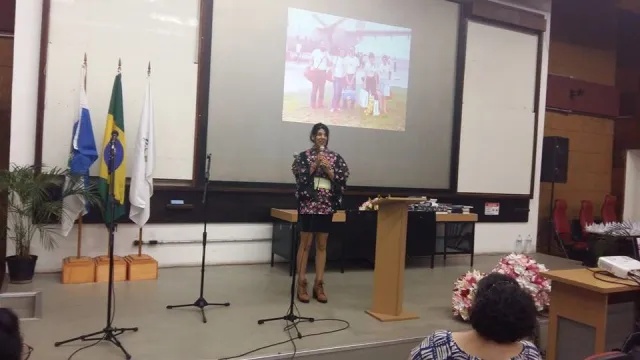
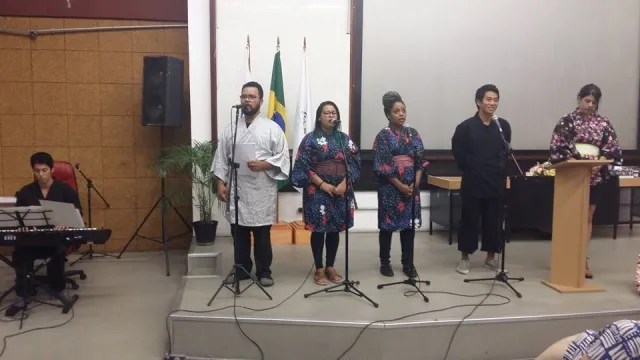
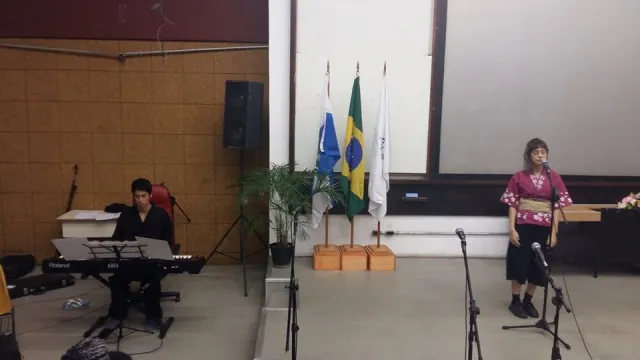
November Activity Report
30 November 2018
Global Japan Office Coordinator
Leonardo Brescia de Sousa Henriques
This month, on 27th, it was held in the Odylo Costa, filho Theater, at the Rio de Janeiro State University (UERJ), the event “O Japão na UERJ” (Japan at UERJ). This was the biggest event held at the Rio de Janeiro State University to celebrate the 110th anniversary of the Japanese immigration to Brazil. It was co-organized by the General Consulate of Japan in Rio de Janeiro, the Department of Japanese of UERJ, the Global Japan Office, the Theater Department of UERJ, the Rio Nikkei Taiko and the Rio de Janeiro Soloists Orchestra.
This celebration aimed to offer a day of immersion in the Japanese culture and its artistic expressions that have been brought to Brazil along the years of friendship between both nations.
The doors of the theater opened at 15:30 to the public, who could appreciate activities such as kyûdô, judo and cosplayers presentations; could learn to make origami; experience sadô; taste onigiri with karaage, yakisoba, makimono, sashimi and candies made of green tea; contemplate ceiling luminaires made of origami flowers, a timeline of the Japanese immigration, typical Japanese clothing and a replica of a samurai armor. At 19:30, the main attraction started: the concert performed by the Rio de Janeiro Soloists Orchestra conducted by the maestro Rafael Barros Castro, the Rio Nikkei Taiko, the pianists Midori Maeshiro and Ryo Sato, and the singers Bianca Pinheiro Machado, Bruno Vinicius da Silva, Joyce Dias da Silva, Julie Yukari Misumi, Kenta Hashimoto and Marina Coelho.
All these activities could be realized thanks to the commitment and cooperation of Departments of UERJ, independent collaborators and Institutions such as the Kyûdôkai, headed by Prof. Elisa Figueira; the Physical Education College of UERJ, represented by Prof. Iedda de Almeida Brasil and Prof. Fabio Sancho; Prof. Naomi Matsubara and Mari Fujiwara (JICA), who offered the Tea Ceremony experience to the public; the Cosplayers; Prof. Elisa Massae Sasaki, who offered the origami workshop; Prof. Satomi Takano Kitahara, coordinator of several activities; the support of the LICOM, a project of the Institute of Letters; the musicians Vinicius Kleinsorgen and William Massao Watanabe, composers and arrangers of some songs performed in the event; the students of Japanese at UERJ; the Japanese exchange students, among several other collaborators.
Below are some pictures taken in the event.
1) The presenters of the show, Kenta Hashimoto, TUFS exchange student at UERJ, and Barbara Kontz, current UERJ student and former exchange student at TUFS.
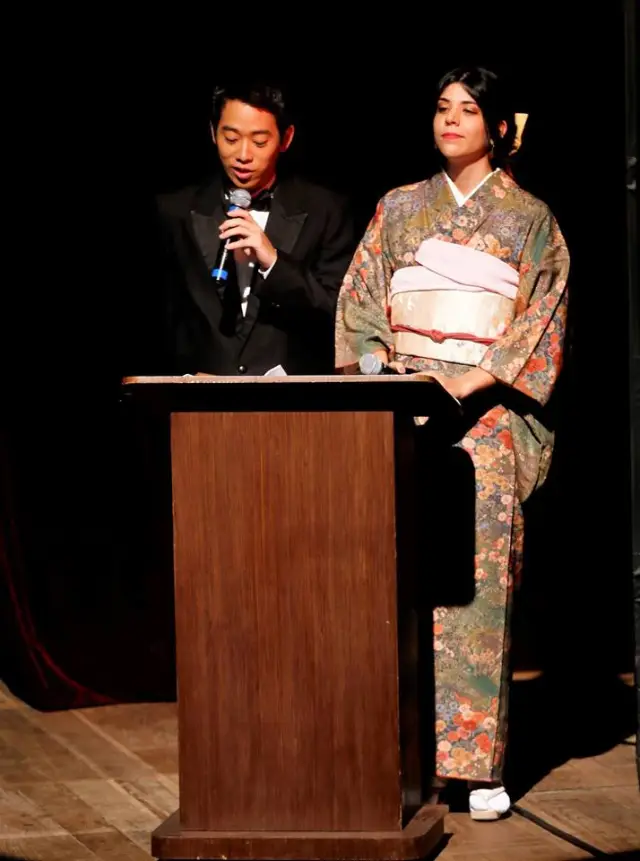
2) The students of UERJ Marina Coelho (on the left) and Julie Yukari Misumi (on the right), former exchange student at TUFS, who sang Mononoke Hime and Itsumo Nando Demo along with the Rio de Janeiro Soloists Orchestra, conducted by Maestro Rafael Barros Castro.
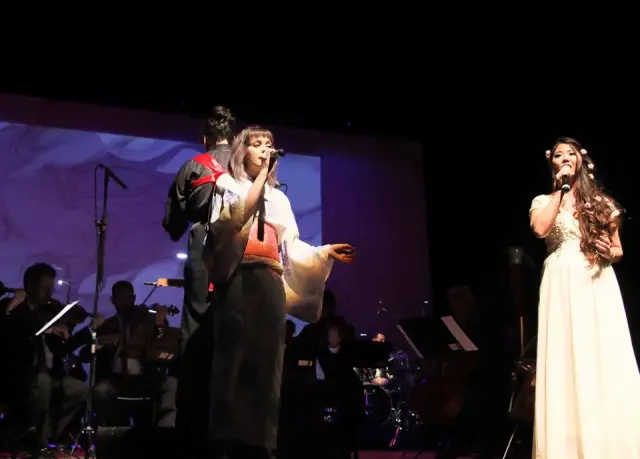
The Rio de Janeiro Soloists Orchestra, conducted by Maestro Rafael Barros Castro, and Julie Yukari Misumi, in foreground.
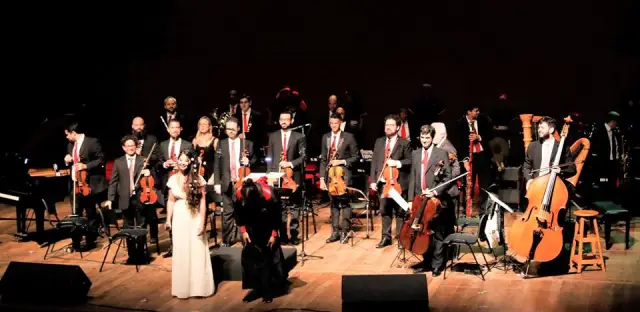
3) From the left to the right, Joyce Dias da Silva, Bruno Vinicius da Silva, Barbara Kontz, Bianca Pinheiro Machado and Kenta Hashimoto singing the famous song Itsudemo Yumewo. The four Brazilian singers are students of Japanese at UERJ. Barbara and Bruno were exchange students at TUFS in 2016 and 2017 respectively. Kenta Hashimoto is an exchange student from TUFS.
In the background of the stage, the screen made of tsuru.
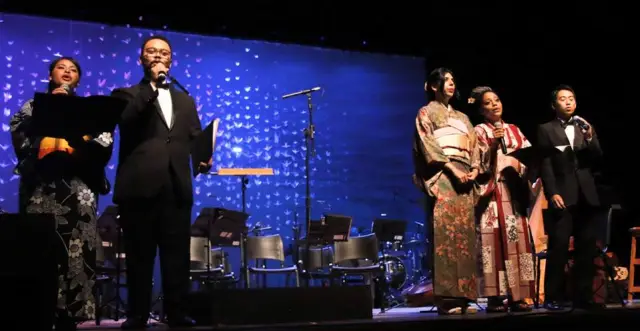
4) Ryo Sato, exchange student from TUFS, was one of the pianists of the night.
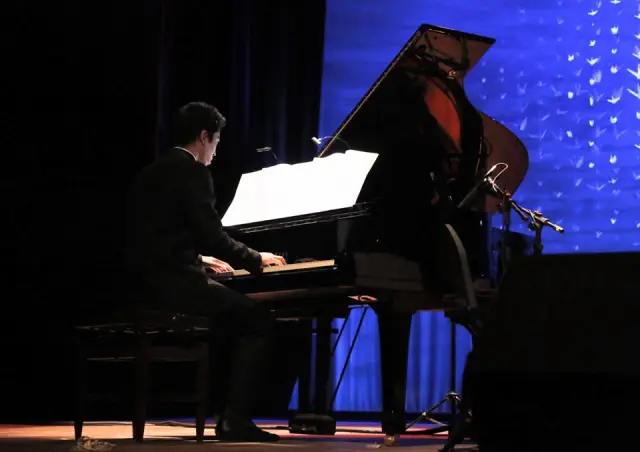
5) On the stage, the Rio Nikkei Taiko, that this year celebrates 15 years of existence, performing the song Rio no Kawa, an arrangement based on the famous song Kawa no Nagare no Youni, with four singers (in the center), before the final song Ashita ga Aru. In the background, the screen of tsuru.
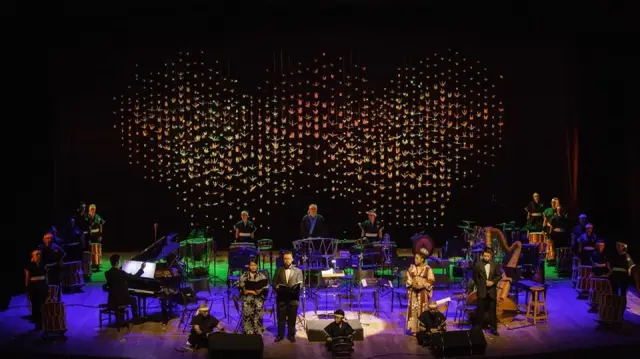
6) The Pop culture represented by the Cosplayers in the hall of the theater.
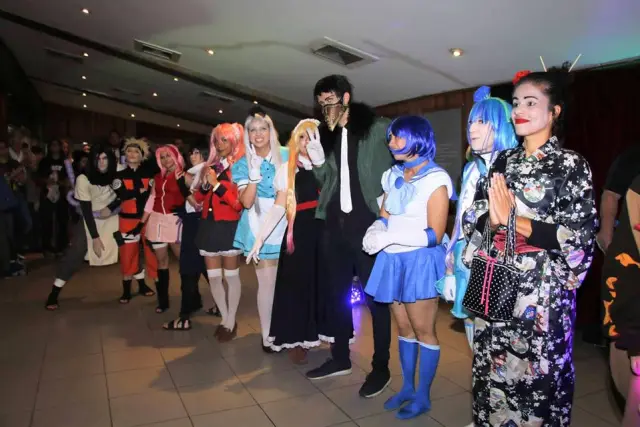
7) Professor Mari Fujiwara, from JICA, teaching the Tea Ceremony to Brazilians. This workshop was possible thanks to Prof. Naomi Matsubara, who lent the Tea Ceremony utensils to the event and also acted as an instructor.
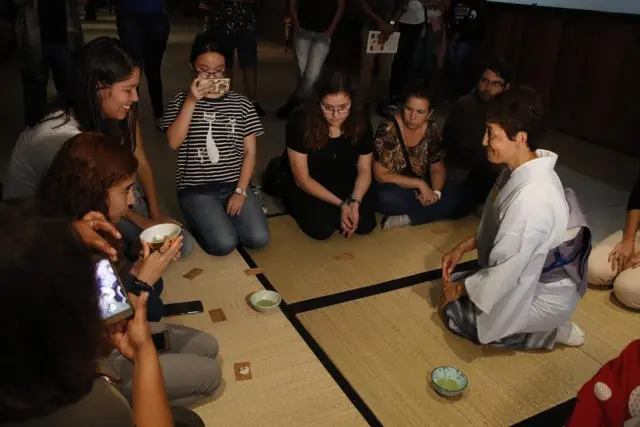
8) Presentation of Judo by the Judo team of the Physical Education College of UERJ, conducted by Prof. Iedda de Almeida Brasil (in the foreground) and Prof. Fabio Sancho (on the left).
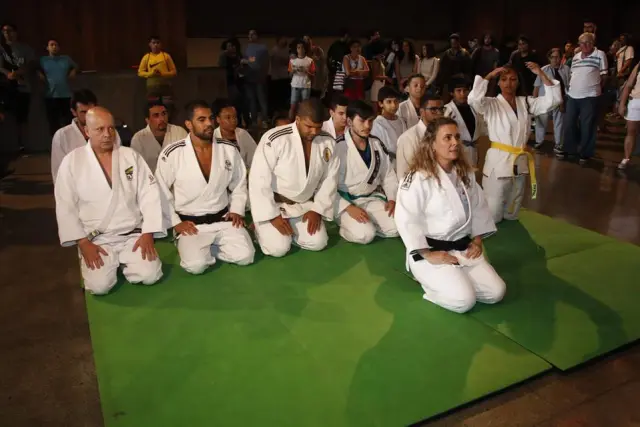
9) Prof. Elisa Figueira de Souza Corrêa during the presentation of Kyûdô. Prof. Elisa is a Japanese Language Professor at UERJ, founder of the Kyûdôkai in Rio de Janeiro and former exchange student at TUFS, in 2005, where she had her first contact with kyûdô. Currently she holds a fourth dan in Kyûdô, the higher grade in Brazil.
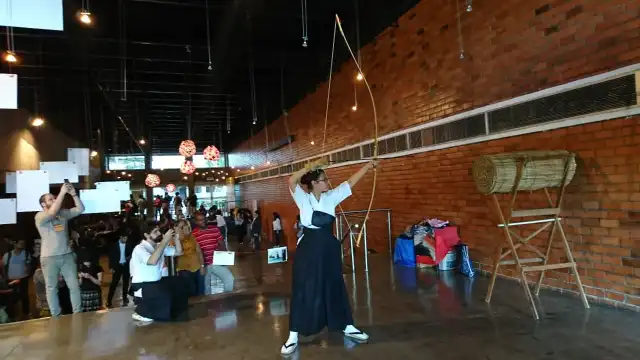
10) Prof. Elisa Massae Sasaki in the origami workshop, teaching the public how to make tsuru. Weeks before the event, Prof. Elisa made other origami workshops in which she taught how to make not only tsuru, but some flowers. The total of origami was over 3,000 units, much of it being used in the production of a screen of origami tsuru, used on the stage for the event, and for the making of ceiling luminaires of origami flowers.
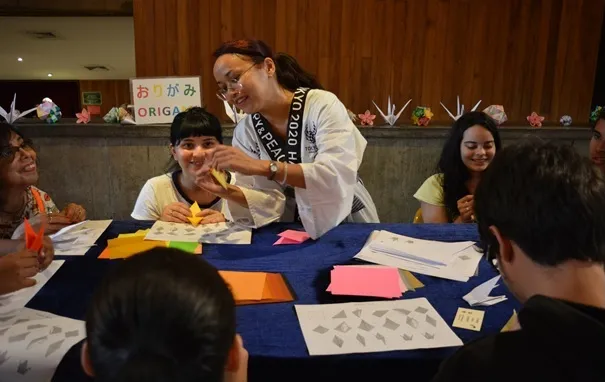
October Activity Report
31 October 2018
Global Japan Office Coordinator
Leonardo Brescia de Sousa Henriques
1) This month, Mr. Takashi Okuda, researcher of the General Consulate of Japan in Rio de Janeiro, gave the lecture “Tourism in Japan”. The lecture was organized by the Department of Japanese of UERJ along with the General Consulate of Japan in Rio de Janeiro and the Global Japan Office. Mr. Okuda talked about the most visited places in Japan by foreign tourists and those visited by the Japanese. He presented the impact of tourism in Japan that intends to stand out as a tourist destination, the importance of this activity as part of the strategies of economical growth of the Japanese Government and analyzed the change in trend of the foreign visitors in the Japan.
The theme of the event attracted a lot of Brazilians fond of Japan and certainly touched the imaginary of the whole audience.
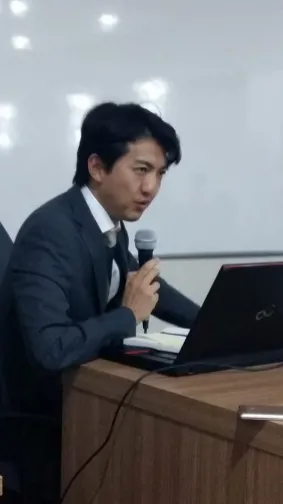
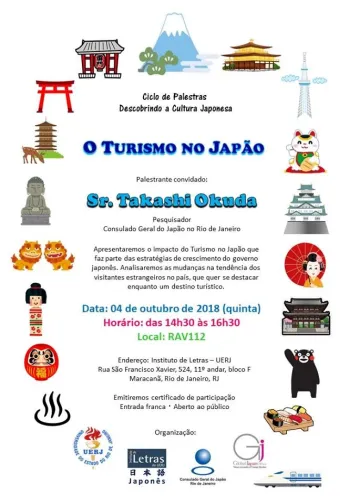
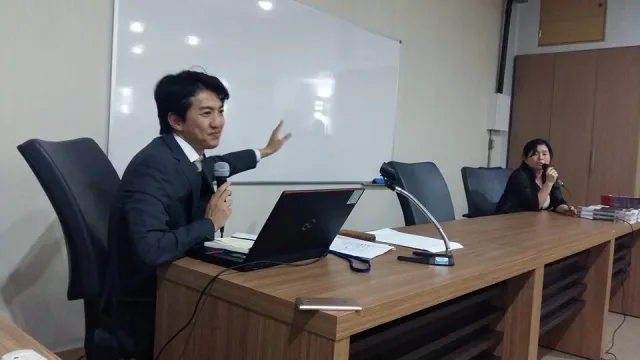
2) For the first time at UERJ, we had a workshop of the traditional tea ceremony. The workshop took place on 9 October in the Minato Laboratory that recently received tatami. The instructions and explanations were given by Prof. Matsubara and translated by Prof. Elisa Massae Sasaki who acted as an interpreter for the students of Japanese Culture and Literature that do not master Japanese yet.
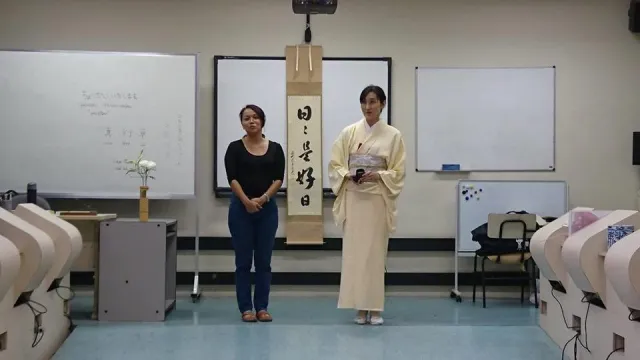
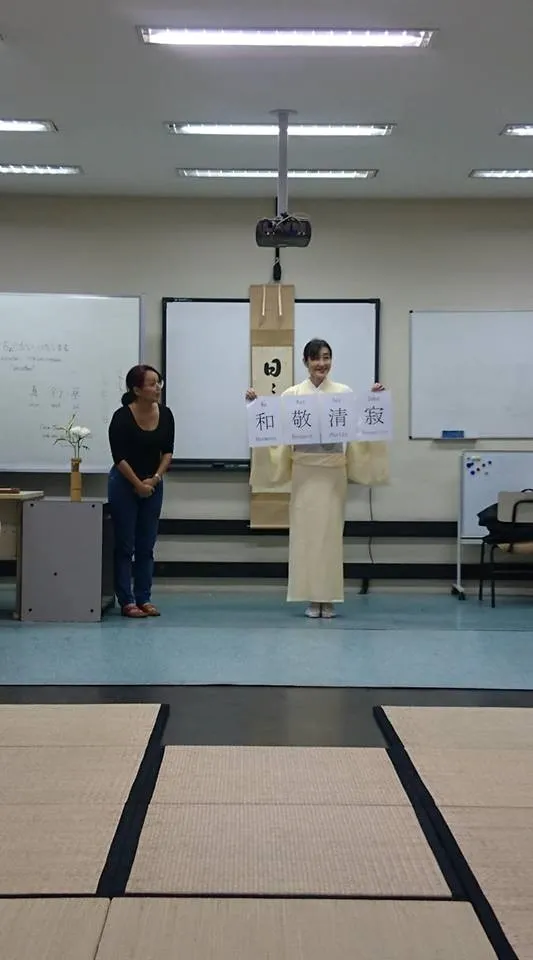
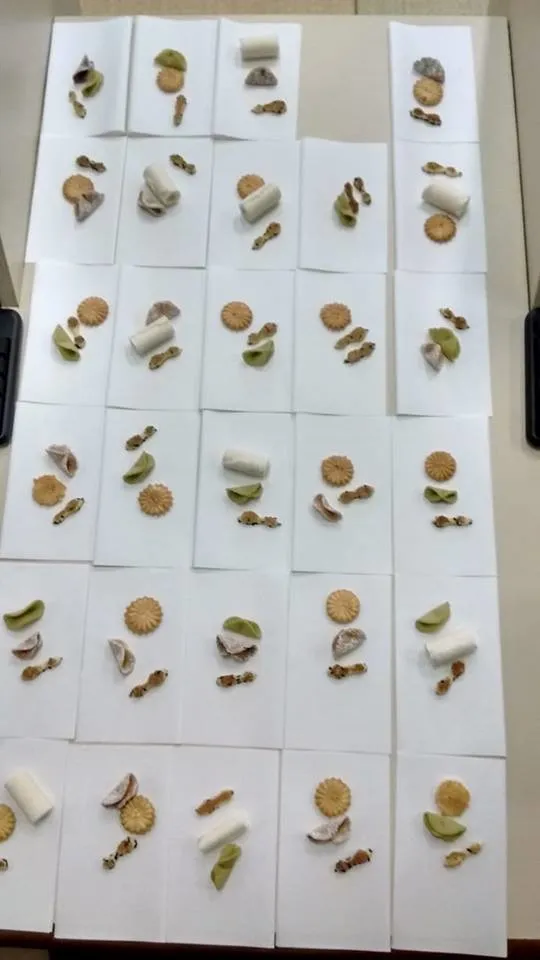
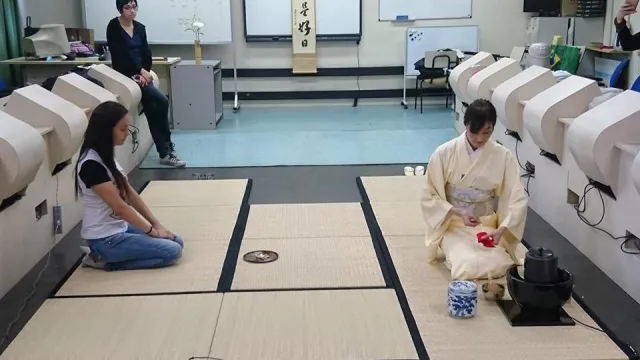
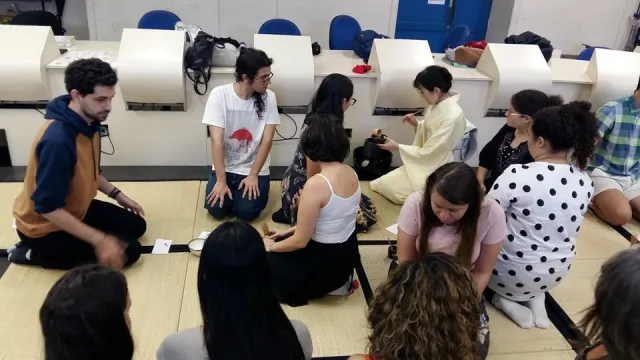
September Activity Report
30 September 2018
Global Japan Office Coordinator
Leonardo Brescia de Sousa Henriques
1) Annually, the Rio de Janeiro State University holds an event called “UERJ sem Muros” (UERJ without walls), in which the academic results produced by the whole University, in its various fields of knowledge, are presented to the society. It involves teaching, research, extension and culture and counts on the participation of the whole academic community and collaborators.
As expected, the students of Japanese Studies also presented the results of their research and activities with support of the Professors of the Japanese language and culture. During the event, professors that act as examiners listened to the explanation of the students about the projects and awarded them a mark. Below we can see some images of their presentations during the event that was held from 24 to 28 September.
The projects presented by the Japanese Department were:
• ELONihon – Media Studies (picture 1)
• Japanese Course Language at Pedro II School (picture 2)
• Interpreting the Japanese Universe – Translating Practice from Japanese to Portuguese (picutres 3 and 4)
• Training Young People for the Future: Japanese Language Courses at School (picture 5)
• Center for Developing Teaching Materials for Japanese Language and Culture (picture 6)
• Discovering the Japanese Culture (picture 7)
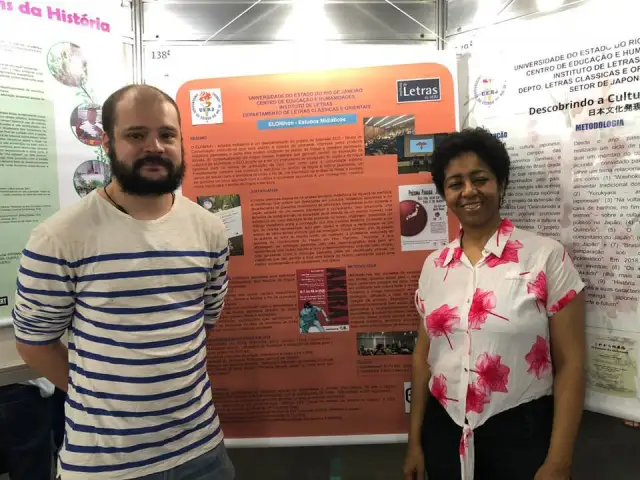
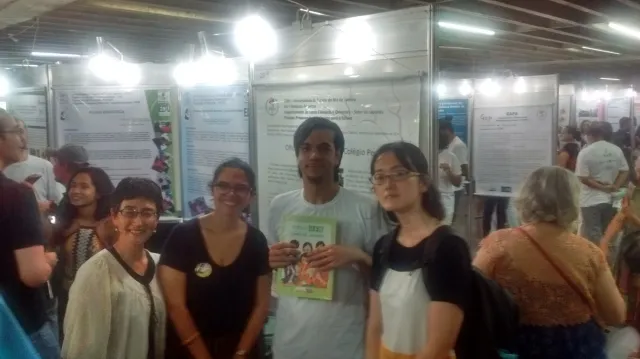
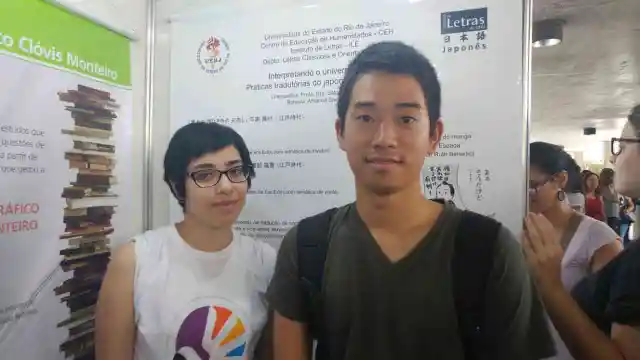
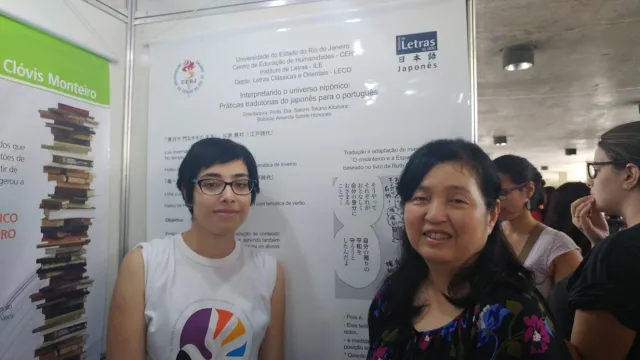
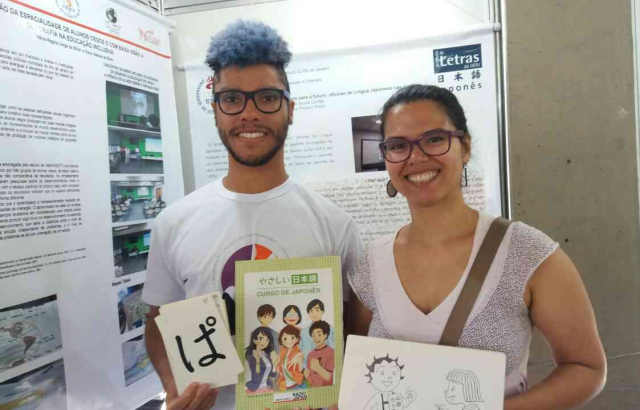
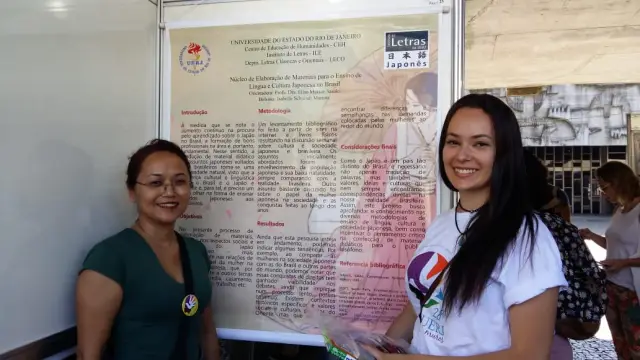
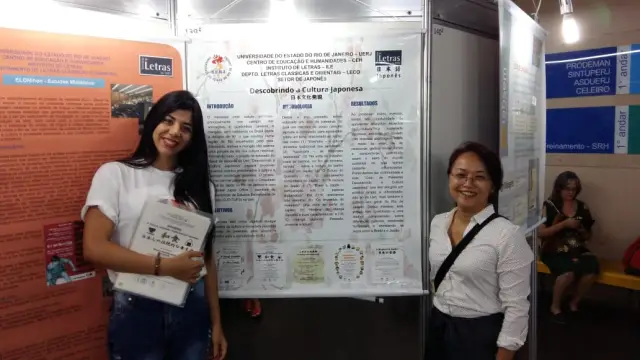
2) From 18 to 28 September, four TUFS students visited Rio de Janeiro. During their stay in Rio, we were pleased to welcome them at the Rio de Janeiro State University and Global Japan Office. For the most of the time, they had the support of the exchange student Kenta Hashimoto, who acted as a guide and took them to several beautiful places in the city.
We hope to meet them again soon in Rio and welcome other students from TUFS as well.

30 September 2018
Global Japan Office Coordinator
TAKADA Mayu
1. Japanese Language and Culture Education at Rio de Janeiro State University
In July, I was dispatched as a JICA Youth Volunteer for Nikkei Communities, and have been working here at the Rio de Janeiro State University Global Japan Office since September.
Here at Rio de Janeiro State University, we are running a project that aims to give teacher-training course students practical training in the actual classroom. For this project, teacher-training students teach Japanese classes twice a week (Tuesdays and Thursdays) with a native Japanese teacher at Colégio Pedro II high school. My predecessor, Kimura, also participated in this project as a native Japanese teacher. Recently, JICA senior volunteer Fujiwara and university student Pedro have joined the project as native Japanese teacher and teacher-training student respectively, and so they are getting a fresh start and enjoying studying Japanese with the students.
On September 24, a project presentation was held by students at Rio de Janeiro State University. The students talked about what teaching materials they have been using and the manner of the high school students studying Japanese. People who came to watch the presentation asked many questions about teaching Japanese, which led to lively discussions and an overall successful event.
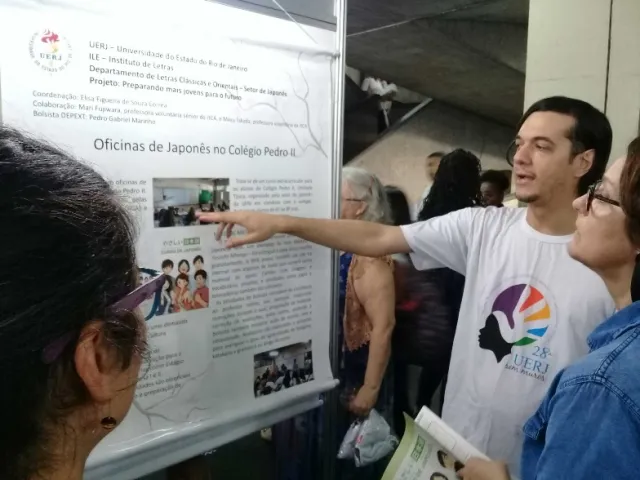
2. Nikkei Organizations and Japanese Language and Culture Support
São Paolo has the largest number of Japanese immigrants in Brazil, but there are also many Japanese immigrants living in Rio de Janeiro, and there are even organizations established by Japanese immigrants. I have been supporting the Japanese language education efforts of one such organization, the Nikkei Association of Rio de Janeiro, at their Japanese Language Model School. This language school was originally built as a place for Japanese immigrants to keep up their Japanese language education, but now students of all kinds of backgrounds, and not just Japanese descendants, study here. As the times change, so do the types of students and their motivations for studying Japanese, and so we also have to think about the teaching materials and how the school should operate. I want to keep cooperating with teachers to make the Japanese language education at this school even better.
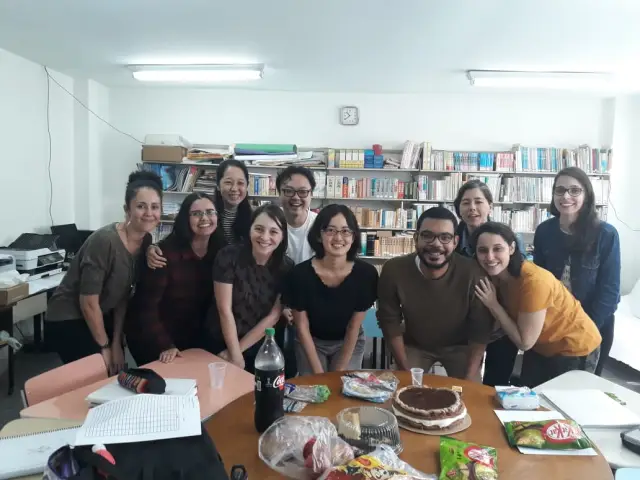
August Activity Report
31 August 2018
Global Japan Office Coordinator
Leonardo Brescia de Sousa Henriques
1) This month we had an illustrious guest at UERJ, the Japanese Ambassador in Brazil, Mr. Akira Yamada, who gave the lecture entitled “The Japanese Manga – Past, Present and Future”, on 9 August. Mr. Akira contextualized Manga as an important cultural genre to understand Japan. He talked about its history, its main themes and its development from the second half of the 20th Century to the present day. This event was organized by the Japanese Department of Rio de Janeiro State University, the General Consulate of Japan in Rio de Janeiro and the Global Japan Office of the Tokyo University of Foreign Studies.
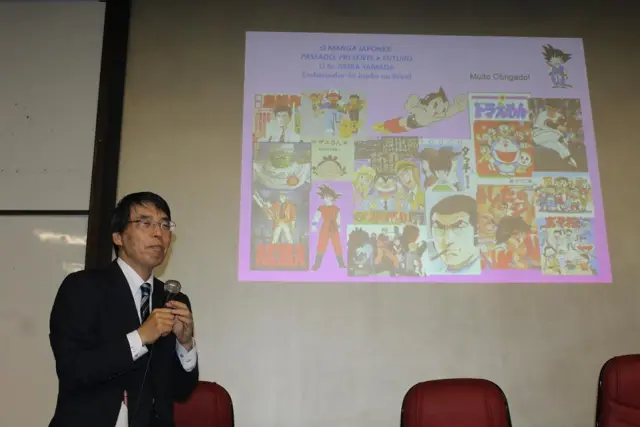
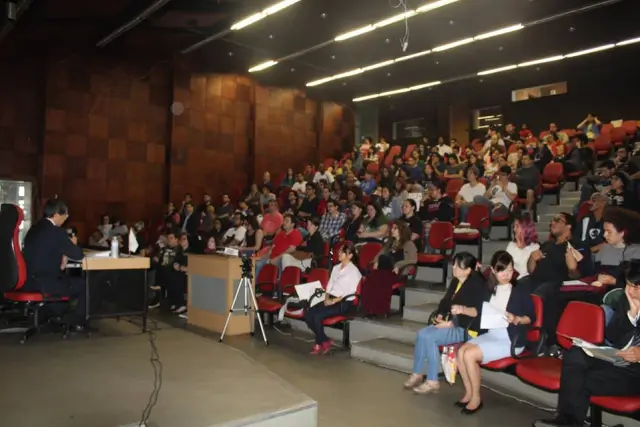
Before the lecture, the Japanese Department offered a breakfast to the Ambassador, Professors and Students.
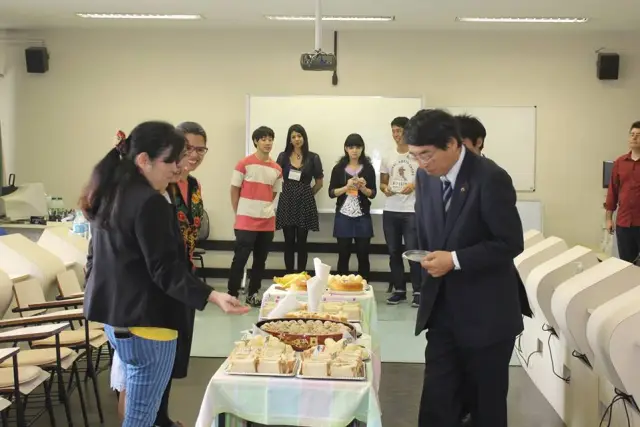
2) On 2 August, the recently arrived teacher Ms. Mayu Takada from JICA visited the Colégio Pedro II, a renowned public school, where a Japanese course is taking place this year conducted by Prof. Mari Fujiwara and coordinated by Prof. Elisa Figueira from Rio de Janeiro State University. Ms. Takada had the experience of teaching the Brazilian students for one day. That was a pleasant day for both students and teacher and a great opportunity to the students to practice Japanese with one more native speaker.
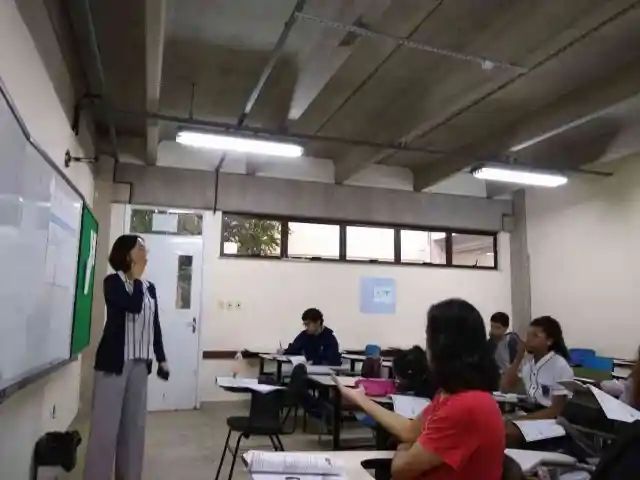
3) At the end of the month, we said goodbye to three talented young students, who were selected to participate in the La-Cep program this year at TUFS. Ms. Glaucia Galvão Pereira de Souza, Ms. Gabriela Rebelo Bastos da Silva and Ms. Ana Cecilia Penna Schinke will finally make a big dream come true: study in Japan for almost one year, visit the country and experience the Japanese way of life, after years of hard work studying the language and culture of Japan in Brazil.
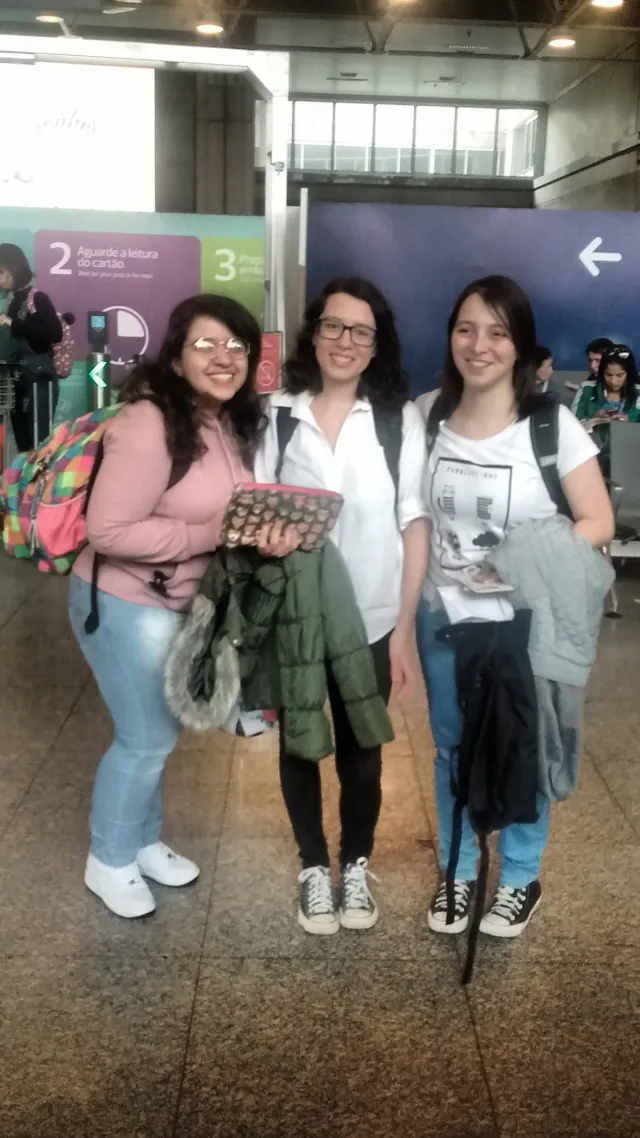
July Activity Report
31 July 2018
Global Japan Office Coordinator
Leonardo Brescia de Sousa Henriques
This month we had three big events regarding the celebrations of the 110 years of the Japanese Immigration in Brazil at Rio de Janeiro State University (UERJ).
In the first of them, held on 5 July, entitled Road of Light and Hope, the renowned artist Miro Ito talked about the evidences on the interconnectivity of East and West, such as Buddhist statues with influence of the Hellenism, and the ancient Gigaku masks whose origin are the masks of the classic Greek theater, that reached Japan through the Silk Road more than fourteen centuries ago. The artist also presented short movies and some of her precious photographic records of the Buddhist art in the Todai-ji temple, located in Nara, considered part of the National Japanese Treasure and World Heritage by UNESCO. In addition to the event at UERJ, an exhibition of her work took place at Correios Cultural Center in Rio de Janeiro from 4 to 29 July.
After the lecture, the audience attended the delightful performance of the ballet master and dancer Mr. Shunso Arai. Mr. Arai made a dancing presentation with a Gigaku mask replica, out of the auditorium, so that a larger number of people could appreciate his magnificent performance.
We are very thankful to both of them for sharing their wonderful work with the Brazilian community at UERJ.
Credits:
The Lecture & Short Movie screening (at UERJ): “Road of Light and Hope” by Miro Ito (Co-organized by Consulate General of Rio de Janeiro and the Rio de Janeiro State University); Exhibition & Short Movie screening: “Road of Light and Hope” by Miro Ito (co-organized by the Japanese Consulate General to Rio de Janeiro, Media Art League and Japan Camera Industry Institute “JCII”); Gigaku Performance (Produced by Media Art League, Artistic Direction by Miro Ito, Performed by Shunso Arai); Konron Gigaku Masks (Replicas of Todai-ji Temple’s 8th century mask, Collection of Media Art League)
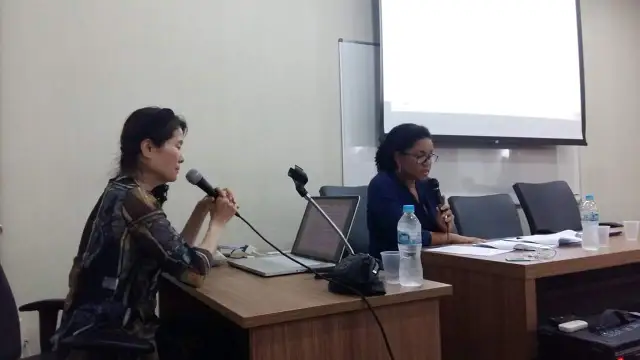
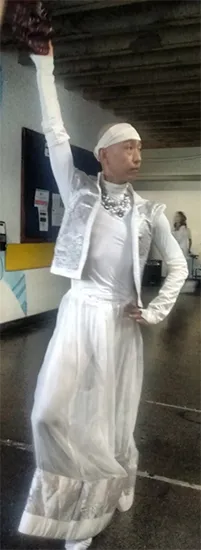
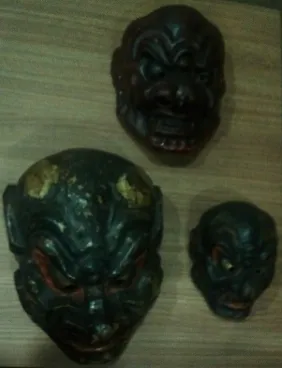
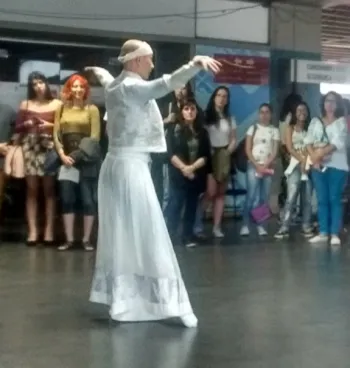
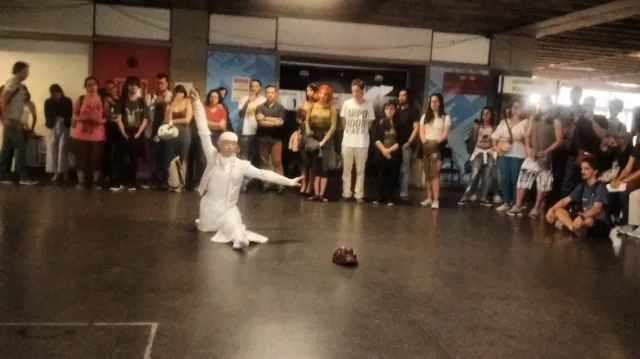
The second event of the month, held on 24 July, at the “Odylo Costa, filho” theater, at UERJ, was about an art appreciated by the most of the people: Gastronomy!
“Washoku – Japanese Cuisine Beyond the Five Senses” was the title of the event, organized by the Japanese Ministry of Agriculture, Forestry and Fisheries of Japan (MAFF); the General Consulate of Japan in Rio de Janeiro and the Japanese Department of UERJ, with support of the theater staff and the Global Japan Office.
At first, there was a presentation of the chefs to the audience: Mr. Shin Koike, Mr. Hirokazu Tomisawa and Mr. Naoyuki Yanagihara, ambassadors to spread Japanese food culture, and Mr.Eduardo Nakahara, the best Sushi Chef in Brazil (2016) and finalist of the World Cup Sushi in 2017. The presentation was followed by a debate between the chefs Koike and Nakahara on the flavors of the Japanese cuisine. After that, there was a demonstration on how to prepare some Japanese food by the chefs Tomisawa and Yanagihara. In the end, there was a tasting of futomaki zushi prepared previously by the chefs.
The demonstration had as focus to show techniques with natural ingredients used in Japanese cuisine, aiming at reducing salt and fat in food.
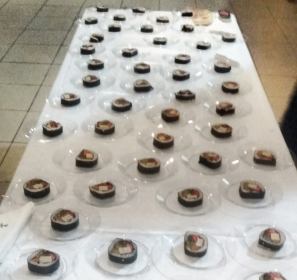
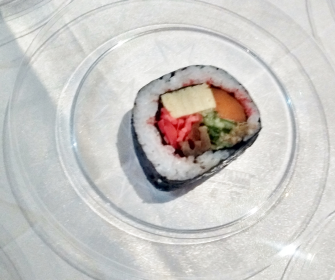

The last event of the month, also held at the theater of UERJ “Odylo Costa, filho”, on 25 July, was a fascinating presentation of the taiko group Ondekoza. The event was organized by the Association for Exchange and Promotion of Japanese Culture, the General Consulate of Japan in Rio de Janeiro and the Japanese Department of UERJ. Once again, the theater staff of UERJ and the Global Japan Office gave support to the organization of the event.
The Ondekoza originated from the Island of Sado in 1969 under the direction of Den Tagayasu. Since then, the group has expanded its activities to the world, popularizing taiko and having its artistic performance recognized as one of taiko’s exponents.
For about one hour and half, over than 600 people could enjoy the delightful show. For most of the people, this was the first opportunity to attend a taiko performance live.

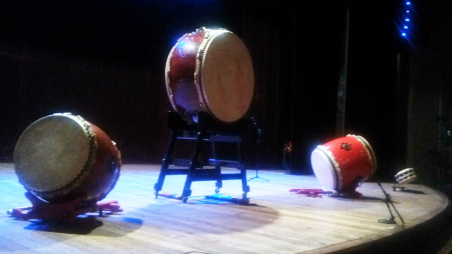
June Activity Report
30 June 2018
Global Japan Office Coordinator
Leonardo Brescia de Sousa Henriques
On 14 June, it was held the second lecture of the year about Japan at Rio de Janeiro State University (UERJ)was held, organized by the General Consulate of Japan in Rio de Janeiro, the Department of Japanese of UERJ and the GJO. Mr. Eiji Takeya, Vice Consul in Rio de Janeiro, made a presentation about the History of the Japanese Manga. It was a huge success and the audience filled the auditorium.
Through the lecture entitled “日本マンガの歴史とその特徴”, the participants listened to the origin of Manga in Japan and its evolution along the time to nowadays. Considering the enormous interest about the theme, we hope to schedule a new date to repeat the presentation of Mr. Takeya in a bigger room at UERJ, so that more people can attend his brilliant lecture and learn more about the subject.
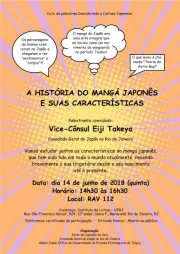
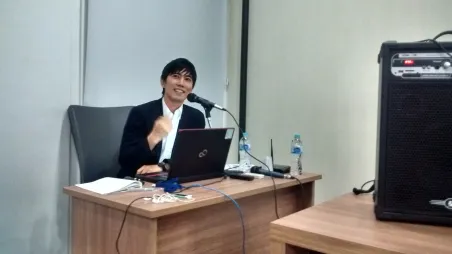
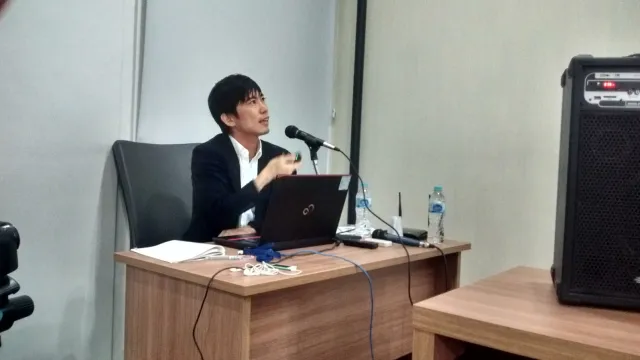
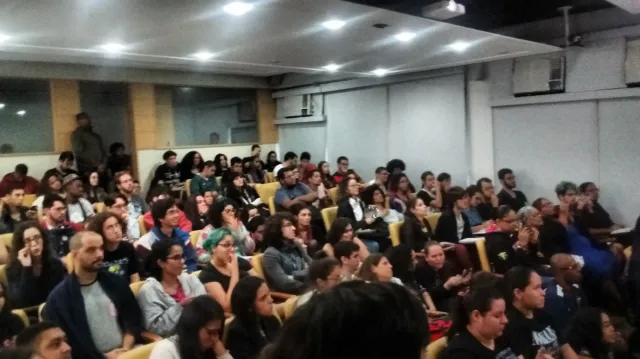
In June, the Japanese-language course for elementary and high school students at Instituto de Aplicação Fernando Rodrigues da Silveira (CAp-UERJ) was reassumed. The course is coordinated by Prof. Elisa Figueira de Souza Corrêa. It is supported by the GJO and participation of Mr. Moisés Paulino Polzin, intern of the Japanese Department, who is giving classes under the guidance of the Coordinator. It is an introductory course that aims to divulgate the Japanese language and culture among young Brazilian students.The school (CAp-UERJ) is an academic unit of UERJ, and its purpose is the initial and continuing teacher training in partnership with other academic units of the University and the promotion of basic education of high quality, as well as the promotion of activities of research in teaching and education.
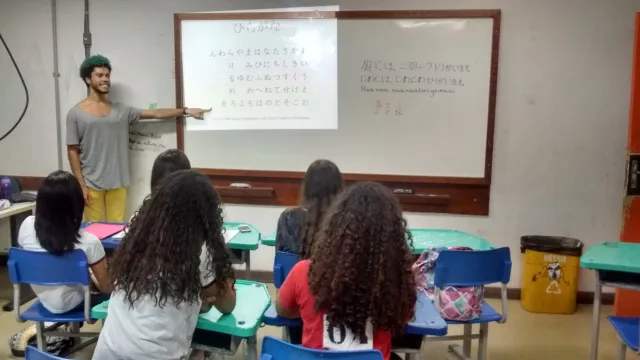
May Activity Report
31 May 2018
Global Japan Office Coordinator
Leonardo Brescia de Sousa Henriques
1. This month, a new Japanese course started in the city: the Japanese course for elementary and high school students at Colégio Pedro II, a traditional federal public school. The course is given by Prof. Mari Fujiwara (JICA), coordinated by Prof. Elisa Figueira de Souza Corrêa (UERJ) and supported by GJO.
As expected, as soon as the course was introduced to the school, several students were interested in attending the classes. Finally, two classes of about 20 students were formed, one class in the morning and the other in the afternoon.
Besides disseminating the Japanese language and culture, the course serves as an internship field for Japanese students of UERJ who will become teachers of Japanese language in the future.
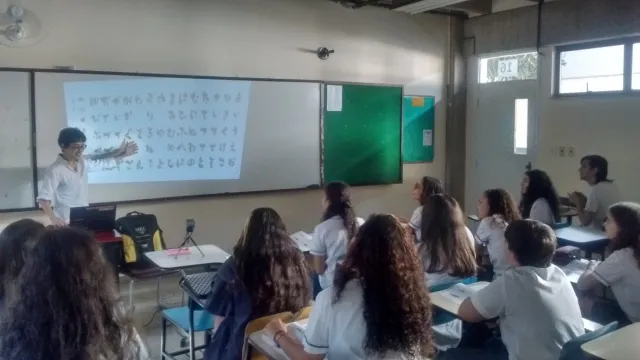
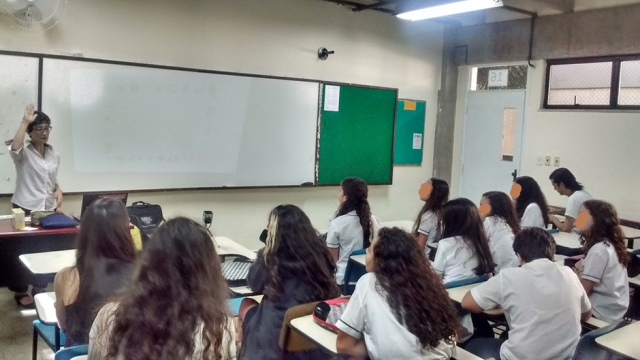
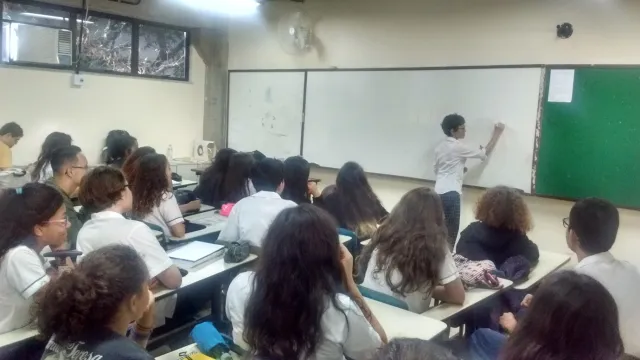
2. On 18 May, an event was held to welcome the new undergraduate students to the Department of Japanese. Firstly, the professors of the Department of Japanese, Satomi Takano Kitahara, Janete da Silva Oliveira, Elisa Figueira de Souza Corrêa, Elisa Massae Sasaki were introduced to the new students. They explained about the undergraduate course and the projects developed by the Department of Japanese. The event counted also on the presence of Prof. Nabil Araújo de Souza, representative of the Direction of the Institute of Letters, Prof. Davi Ferreira de Pinho, Coordinator for International Affairs of the Institute of Letters, and Prof. Mari Fujiwara from JICA.
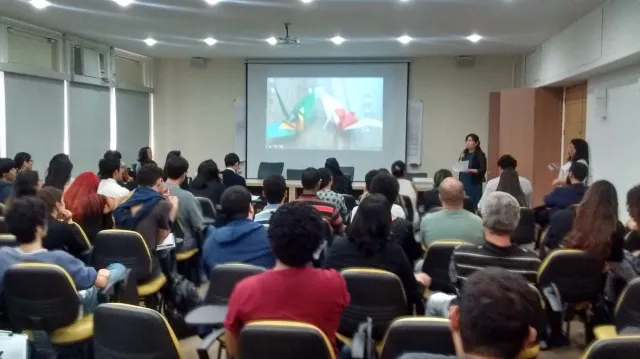
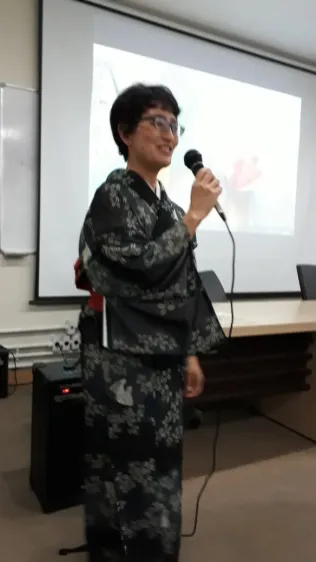
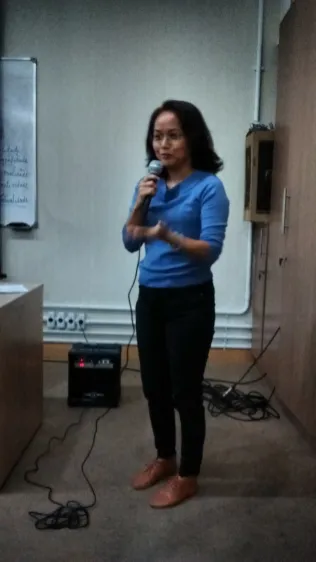
In the second part of the event, international programs with scholarships offered by MEXT and JASSO were introduced. The Vice Consul Mr. Eiji Takeya and Ms. Gabriela Yussa talked about the opportunities of studying in Japan through the selection of the General Consulate of Japan in Rio de Janeiro.
Regarding the opportunities reserved only for the students of UERJ, I presented the programs of the Japanese Universities, with which UERJ has an agreement: TUFS, Waseda University, Kwansei Gakuin and Kanazawa University. In addition, I briefly explained the GJO and the importance of the Japanese-Language Proficiency Test for those who intend to study in Japan.
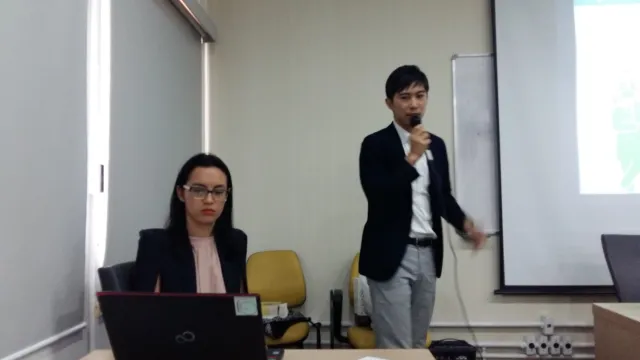
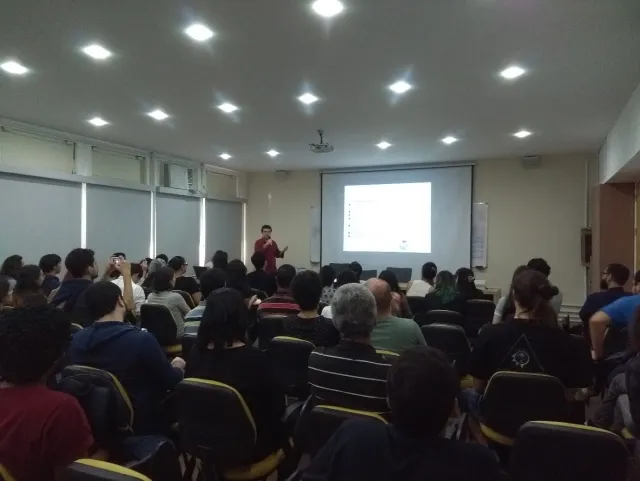
The third part of the event consisted in presentations of the Japanese students of TUFS and the former exchange students of UERJ in Japan. At first, Ryuhei Togo, Shodai Yamashita, Taketo Kikuchi, Ryo Sato, Kenta Hashimoto, Erika Miyashita made presentations in Portuguese on diverse topics that have to do with their experiences, interests, motivations and surveys. The young Consul Mr. Takuya Okumura also talked about his experiences in Brazil.

After that, four former Brazilian exchange students of TUFS: Eliane Vieira Tacaqui, Raquel Cristina Danzer de Souza Benedito, Max Daniel Silveira de Freitas, Barbara Silva Kontz as well as Renan Liduino do Nascimento, former student at Dōshisha University (Kyoto), reported their experiences in Japan and encouraged the new students to participate in exchange programs in Japan.
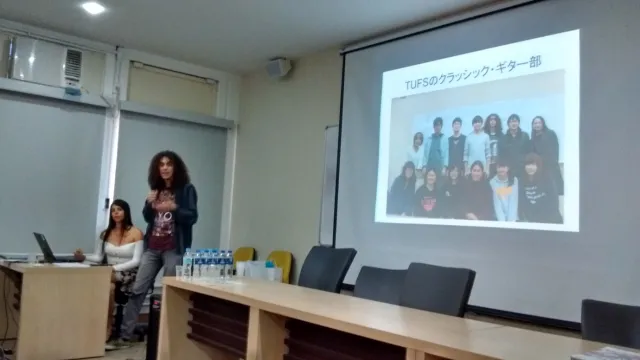
At last, gifts from Japan, provided by the professors of the Japanese Department, were distributed as well as Nipponia magazines, offered by the General Consulate of Japan in Rio de Janeiro.
3. Closing the month, a cultural event, that we called “karê party” was held on 25th. In the occasion, the Brazilian students were taught how to prepare karê and it was celebrated the birthday of Shodai Yamashita and Taketo Kikuchi. Congratulations to them!
April Activity Report
1 May 2018
Global Japan Office Coordinator
Leonardo Brescia de Sousa Henriques
1. This month, it was held the first of a series of lectures about Japan that will take place along the year at Rio de Janeiro State University (UERJ). These lectures will be organized by the Department of Japanese of UERJ, the General Consulate of Japan in Rio de Janeiro and the GJO and will discuss themes such as culture, security and society. On 19th April, the Vice-Consul Ms. Kaori Ueno made a great presentation about Hokkaido, her homeland, as a form of celebrating the 150 years of development of this beautiful land. Through the lecture entitled “北海道の魅力”, or in Portuguese “Os Encantos do Japão”, the audience could learn a lot about the land and its people in a very didactical way. After the presentation, a large number of people asked questions related to different aspects of Hokkaido, such as its geography, customs of the people, historical aspects, the linguistic variation and the Ainu people. We are sure that we will have a year full of interesting and successful lectures as this one.
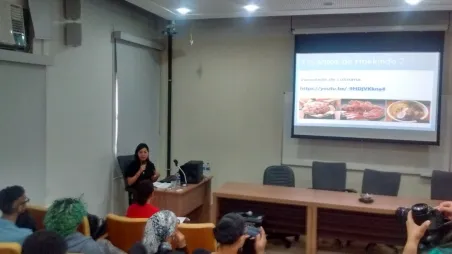
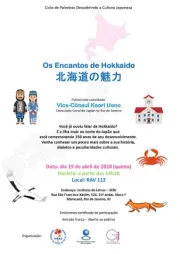
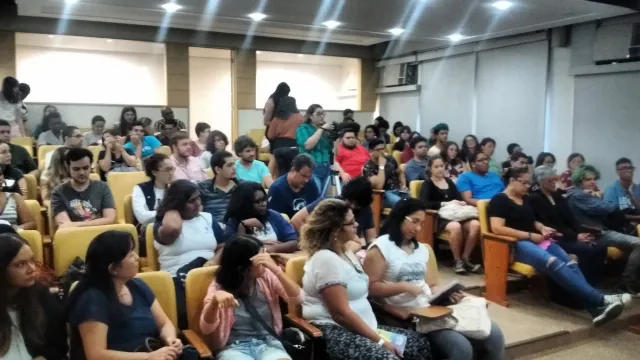
2. Before the beginning of the lecture 北海道の魅力, the new exchange students and other two that have been living in Rio for some months, Mr. Ryuhei Togo and Mr. Shodai Yamashita, talked for a few minutes, in Portuguese, about their first impressions and experiences in Rio and the importance of participating in an exchange program
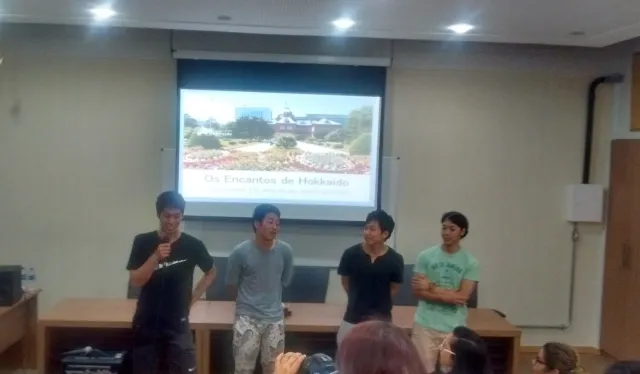
3. On 2nd April, we had the pleasure to welcome two exchange students from TUFS who will study at Rio de Janeiro State University for about one year: Mr. Ryo Sato and Mr. Kenta Hashimoto. Both of them are students of Portuguese at TUFS and came to Brazil to experience the Rio de Janeiro daily life and to enhance their fluency in the language. We wish them a fruitful and fun stay in Rio.
